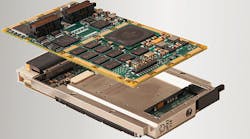This file type includes high-resolution graphics and schematics when applicable.
In 2015, VITA added 20 new members to its roster, driven primarily by activities within the VPX and FMC working groups. Each of these specifications has new development in process that will broaden their appeal in their respective application markets. Companies from all reaches of the world are interested in participating or learning more about what each of these standards can do to help solve their critical embedded computing needs.
More work remains, as 2016 promises to continue with more improvements on the roadmap, including a rekindling of VITA’s international appeal. This would help reinforce VITA’s tradition of creating the best open architectures, with open standards remaining the sole focus.
Stability in Military Programs in Sight
Last year, I commented that many programs are stabilizing. Today, I think they are about as stable as they are going to get, given current economic and political conditions. Big contracts have been awarded, but will be contested as expected. However, eventually they will move forward.
We have entered a new era of warfare that depends much more on intelligence gathering and analysis. The next battles may be fought more with the Internet in cyberspace than with conventional weapons. Defense programs will continue to spend heavily on autonomous weapon systems, such as unmanned aerial, ground, and water vehicles.
The global economy is still very unstable and the political environment even more so. Unrest in the Middle East will not calm down in the foreseeable future, if ever. New leadership in the U.S. will struggle to find suitable methods to deal with terrorism.
The unmanned-aerial-vehicle (UAV) market has expanded to the point where the Association for Unmanned Vehicle Systems International (AUVSI) renamed its premier conference for UAV and robotics technology industry to XPONENTIAL, marking the expansion into the commercial side of the market. Several Defense Department initiatives, such as the U.S. Army’s Modular Open RF Architecture (MORA) initiative, have an open architecture slant that zero in on VPX as a preferred platform architecture. More announcements are expected in early 2016 regarding initiatives that have selected VPX as a central element of the system architecture.
3U Establishes as Form Factor of Choice
The small-form-factor (SFF) fever has subsided somewhat as real products are starting to be deployed. VNX (VITA 74), which is in “trial use” status, is moving ahead to full ANSI accreditation. An active working group has kicked off activities that will complete the process and throw in a few enhancements along the way.
The real focus in 2015 was on 3U VPX, where we saw many new products and design wins. While 3U VPX is on the large end of the SFF size spectrum, the functionality and performance that can be achieved in this size is making it a great fit for larger platforms. The trend to use 3U will continue to expand in 2016. The increased functional density of microprocessors and FPGAs open opportunities for 3U that we haven’t seen since 6U VMEbus first started shipping as single-slot, single-board computers.
Digital Meets RF
Early in 2015, we heard from the U.S. Army’s Communications-Electronics Research, Development, and Engineering Center (CERDEC) about its MORA initiative. Since then, the applied research center has become a sponsor member of VITA to drive embedded industry support for the MORA architecture.
The initiative is expected to support the network-based connectivity of sensors and peripherals on ground vehicles and help speed the deployment of new command, control, communication, computers, intelligence, surveillance, and reconnaissance/electronic warfare (C4ISR/EW) capabilities. Pair this with Mercury Systems’ OpenRFM specification, and you can see how the combination of digital and RF is going to be a hotbed in the coming months.
Tick or Tock?
Intel announced the 6th-gen update to its desktop and mobile processor lines, but the embedded roadmap for these parts are not expected to be released until early 2016. The first quarter should be full of board-level product announcements using these new parts.
Memory Performance Changes the Game
What if a new memory technology was to come along that replaced flash and DRAM, was 1000 times faster, used much less power, was 1000 times more durable than flash, and had 10X the density of conventional memory? Intel and Micron announced in July their new 3D XPoint memory technology, which is just such a product. This could be a huge game changer for the embedded markets, especially since it is projected to be priced at a cost between DRAM and flash. Several other research projects with memory could also get some attention.
Challenges
The landscape of the semiconductor industry is changing, driven by the lure of high unit volume of all kinds of Internet of Things (IoT) devices. Desktop and server processors continue to influence what technology is readily available to critical system architects, but if a large-scale shift is made to IoT devices—then what?
Large consumers of server processors, Google and Amazon among them, are already defining their own server platforms. The next step is to define their own processor solutions, much like Apple does today. These parts aren’t going to be available to the rest of the market.
IoT will change the types of devices developed by semiconductor companies in such a way that it most likely will not benefit the critical embedded-computing industries. Adjustments will be needed, but it is too early to determine what should be done. Members are already questioning what the new NXP/Freescale/Motorola company will look like and how the processor roadmaps may change.
VITA will continue to grow the membership, bringing in more members that are facing similar challenges. Companies from the supply-and-demand side are encouraged to bring their concerns to VITA and join in creating the innovation that will be part of future solutions.


